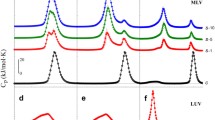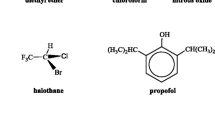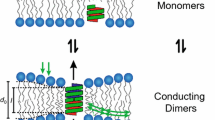Summary
While a plethora of information exists describing particular changes caused by anesthetics on the molecular architecture of membranes, it is clear that models for anesthetic action remain unproven by rigid scientific criteria. This article describes historical and contemporary theories of how anesthetics act on a molecular level, and examines the discrepancies between these hypotheses and current data.
Similar content being viewed by others
References
Meyer HH: Welche Eigenschaft der Anaesthetica bedingt ihre narkotische Wirkung? Arch Exp Pathol Pharmacol 42: 109–118, 1899.
Overton E: Studien über die Narkose. Fisher, Jena, 1901.
Franks NP, Lieb WR: Where do general anaesthetics act? Nature 274: 339–342, 1978.
Janoff AF, Pringle MJ, Miller KW: Correlation of general anesthetic potency with solubility in membranes. Biochim Biophys Acta 649: 125–128, 1981.
Dodson BA, Miller KW: Evidence for a dual mechanism in the anesthetic action of an opiate peptide. Anesthesiology 59: A531, 1983.
Richards CD, White AE: Additive and non-additive effects of mixtures of short-acting intravenous anaesthetic agents and their significance for theories of anesthesia. Br J Pharmacol 74: 161–170, 1981.
Johnson FH, Flagler EA: Hydrostatic pressure reversal of narcosis in tadpoles. Science 112: 91–92, 1950.
Lever MJ, Miller KW, Paton WDM, Smith EB: Pressure reversal of anaesthesia. Nature 231: 368–371, 1971.
Halsey MJ, Wardley-Smith B: Pressure reversal of narcosis produced by anaesthetics, narcotics and tranquillizers. Nature 157: 811–813, 1975.
Miller KW, Paton WDM, Smith RA, Smith EB: The pressure reversal of general anesthesia and the critical volume hypothesis. Mol Pharmacol 9: 131–143, 1973.
Halsey MJ, Wardley-Smith B, Green CJ: Pressure reversal of general anesthesia: a multi-site expansion hypothesis. Br J Anaesth 50: 1091–1096, 1978.
Winter PM, Smith RA, Smith M, Eger EI II: Pressure antagonism of barbiturate anesthesia. Anesthesiology 44: 416–419, 1976.
Smith RA, Dodson BA, Miller KW: The interactions between pressure and anaesthetics. Phil Trans Roy Soc London B 304: 69–84, 1984.
Furmanink ZW Jr, Dodson BA, Miller KW: Is helium pressure equivalent to hydrostatic pressure?: an in vivo test of the critical volume hypothesis. Fed Proc 41: 1620, 1982.
Kita Y, Bennett L, Miller KW: The partial molar volumes of anesthetics in lipid bilayer. Biochim Biophys Acta 647: 130–139, 1981.
Franks NP, Lieb WR: Is membrane expansion relevant to anaesthesia? Nature 292: 248–251, 1981.
Matubayes N, Ueda I: Is membrane expansion relevant to anesthesia? Mean excess volume. Anesthesiology 59: 541–546, 1983.
Pang K-YY, Braswell LM, Chang L, Sommer TJ, Miller KW: The perturbation of lipid bilayers by general anesthetics. A quantitative test of the disordered lipid hypothesis. Mol Pharmacol 18: 84–90, 1980.
Trudell JR: A unitary theory of anesthesia based on lateral phase separations in nerve membranes. Anesthesiology 46: 5–10, 1977.
Trudell JR, Payan DG, Chin JH et al: The effect of high pressure on the phase diagram of bilayers containing dipalmitoyl-dimyristoyl phosphatidytcholine mixtures. Biochim Biophys Acta 373, 141–144, 1974.
Miller KW, Pang K-YY: General anaesthetics can selectively perturb lipid bilayer membranes. Nature 263: 253–255, 1976.
Kamaya H, Ueda I, Eyring H: General mechanisms of anesthesia. In: Fink BR (ed), Molecular Mechanisms of Anesthetics (Progr Anes, Vol 2). Raven Press, New York, 1980, pp 429–433.
Franks NP, Lieb WR: Molecular mechanisms of general anesthesia. Nature 300: 487–493, 1982.
Kiehs K, Hansch C, Moore L: The role of hydrophobic bonding in the binding of organic compounds by bovine hemoglobin. Biochemistry 5: 2602–2605, 1966.
Helmer F, Kiehs K, Hansch C: The linear free-energy relationship between partition coefficients and the binding and conformational perturbations of macromolecules by small organic compounds. Biochemistry 7: 2858–2863, 1968.
Ueda I, Mashimo T: Anesthetics expand partial molar volume of lipid-free protein dissolved in water: electrostriction hypothesis. Physiol Chem Phys 14: 157–164, 1982.
Neubig RR, Boyd ND, Cohen JB: Conformations of Torpedo acetylcholine receptor associated with ion transport and desensitization. Biochemistry 21: 3460–3467, 1982.
Tank DW, Huganir RL, Greengard P, Webb WW: Patch-recorded single-channel currents of the purified and reconstituted Torpedo acetylcholine receptor. Proc Natl Acad Sci USA 80: 5129–5133, 1983.
Schwartz RD, McGee R, Kellar KJ: Nicotinic cholinergic receptors label by [3H] acetylcholine in rat brain. Mol Pharmacol 22: 56–62, 1982.
Lambert JJ, Durant NN, Henderson EG: Drug-induced modification of ionic conductance at the neuromuscular junction. Ann Rev Pharmacol Toxicol 23: 505–539, 1983.
Sauter J-F, Braswell LM, Miller KW: Action of anesthetics and high pressure on cholinergic membranes. In: Fink BR (ed), Molecular Mechanisms of Anesthesia (Progr Anes, Vol 2). Raven Press, New York, 1980, pp 199–207.
Finer-Moore J, Stroud RM: Amphipathic analysis and possible formation of the ion channel in an acetylcholine receptor. Proc Natl Acad Sci USA 81: 155–159, 1984.
Miller KW, Sauter J-F, Braswell LM: A stereoselective pentobarbital binding site in cholinergic membranes from Torpedo californica. Biochem Biophys Res Commun 105: 659–666, 1982.
Dodson BA, Miller KW: Structurally specific modulation of acetylcholine receptor binding by various barbiturates. J Neurosci 8: 340, 1982.
Dodson BA, Miller KW: Barbiturates allosterically regulate high affinity acetylcholine binding to nicotinic receptors. J Neurosci 9: 161, 1983.
Bowling AC, DeLorenzo RJ: Micromolar affinity benzodiazepine receptors: identification and characterization in the central nervous system. Science 216: 1247–1249, 1982.
Quirion R, Hammer RP, Herkenham M, Pert CB: Phencyclidine (angel dust)/σ ‘opiate’ receptor: visualization by tritium-sensitive film. Proc Natl Acad Sci USA 78: 5881–5885, 1981.
Zaslarsky BW, Mestechkina NM, Rogozhin SV et al: Correlation of hydrophobic character of opioid peptides with their biological activity measured in various bioassay systems. Biochem Pharmacol 31: 3757–3762, 1982.
Stanley TH, Leysen J, Niemegeers JE, Pace NL: Narcotic dosage and central nervous system opiate receptor binding. Anesth Analg 62: 705–9, 1983.
Miller KW: Physical theories of general anesthesia. Weekly Anesthesiology Update 2: 1–8, 1979.
Author information
Authors and Affiliations
Rights and permissions
About this article
Cite this article
Dodson, B.A., Moss, J. Molecular mechanisms of action of general anesthetics. Mol Cell Biochem 64, 97–103 (1984). https://doi.org/10.1007/BF00224766
Received:
Revised:
Issue Date:
DOI: https://doi.org/10.1007/BF00224766




